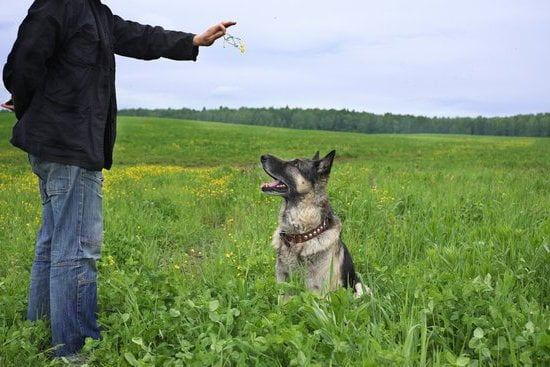Do dogs know they’re trained? This intriguing question has been a topic of curiosity among dog owners, trainers, and researchers for years. In this article, we delve into the fascinating world of canine cognition and explore whether dogs are aware of being trained. We examine their intelligence, learning abilities, perception of the world, and emotional state during the training process. Through case studies, expert opinions, and scientific research, we hope to shed light on this age-old question.
Throughout history, dogs have been beloved companions and faithful working partners to humans. Yet, do they comprehend the concept of training? Can they distinguish between their natural instincts and learned behaviors? To answer these questions, we must first understand canine intelligence and learning capabilities. Scientific studies have shown that dogs possess remarkable cognitive abilities and can learn complex tasks through training. However, understanding the extent to which they perceive themselves as being trained remains a fascinating challenge.
In this article, we will unlock a dog’s learning process from basic commands to more intricate tricks. The use of positive reinforcement and consistency in training will be explored as crucial factors that contribute to a dog’s understanding. Furthermore, we will investigate how dogs perceive the world around them through their senses and examine how these perceptions shape their comprehension of training commands and cues.
Join us as we embark on a journey to unravel the mysteries surrounding canine cognition and awareness of being trained. Through real-life stories from dog owners/trainers and insights from experts in canine behaviorism, we aim to provide evidence-based explanations while debunking common myths or misconceptions along the way. Ultimately, our goal is to shed light on the elusive question: do dogs truly know they’re being trained?
Understanding Canine Intelligence and Learning Abilities
Canine intelligence and learning abilities are fascinating aspects of our furry companions. Understanding these capabilities is essential in exploring the question of whether dogs know they’re trained.
Dogs possess an innate intelligence that allows them to learn and adapt to various situations. They have a remarkable ability to understand human communication, gestures, and even emotions, which contributes to their overall learning process. Furthermore, numerous studies and scientific research have been conducted to delve into the cognitive abilities of dogs.
One such study conducted by Stanford University revealed that dogs have similar cognitive abilities to young children. They can understand human language cues, distinguish between different objects based on their names, and even comprehend pointing gestures. These findings demonstrate that dogs possess a level of intelligence that enables them to grasp the concept of training.
In addition to their intelligence, dogs also exhibit impressive learning abilities. Trainers often employ positive reinforcement techniques, such as offering treats or praise when a dog correctly performs a command or task. This consistency in reward strengthens the association between the behavior and the desired outcome, leading to quicker and more effective learning.
The understanding of canine intelligence and learning abilities is crucial in determining whether dogs are aware of being trained. Their cognitive capabilities paired with their capacity for rapid learning suggests that dogs do indeed know they’re being trained, although we may never fully understand the extent of their awareness. delving into this aspect further will shed more light on this age-old question.
Unveiling a Dog’s Learning Process
The process of training a dog is multifaceted and involves teaching them various commands and tricks. It is important to understand the learning process dogs go through in order to effectively train them. From basic obedience training to more complex behaviors, this section will discuss the different stages of a dog’s learning process.
Training a dog typically starts with teaching them basic commands such as sit, stay, and come. This stage focuses on establishing a foundation of obedience and good behavior. Positive reinforcement plays a crucial role during this phase, as dogs learn best when rewarded for their correct responses. Consistency is also key in the learning process, as dogs thrive on routine and repetition.
Once a dog has learned the basic commands, trainers can gradually introduce more complex tricks and behaviors. This could include advanced commands like roll over or play dead, or even specialized skills like agility training or scent detection. As the difficulty level increases, trainers may use shaping techniques to shape desired behaviors by breaking them down into smaller steps.
Throughout the training process, it is important to keep in mind that each dog learns at their own pace. Some dogs may grasp new behaviors quickly while others may require more time and patience. Understanding and adapting to the individual learning style of each dog is essential for successful training.
| Stage | Description | Example |
|---|---|---|
| Basic Obedience Training | Focusing on teaching fundamental commands such as sit, stay, come. | Teaching a dog to sit by luring them with treats. |
| Intermediate Training | Introducing more complex behaviors, building on the foundation of basic obedience. | Teaching a dog to shake hands or lie down on command. |
| Advanced Training | Developing specialized skills like agility training or scent detection. | Training a dog to weave through obstacles in an agility course. |
Understanding a dog’s learning process is essential for effective training. By recognizing their individual learning style and using positive reinforcement techniques, trainers can help dogs acquire new skills and behaviors. The next section will delve into the role of canine perception in training and how their senses contribute to their understanding of being trained.
The Role of Canine Perception in Training
Canine perception plays a crucial role in a dog’s understanding of training. Dogs perceive the world around them primarily through their senses, including sight, hearing, smell, taste, and touch. These senses contribute to their ability to learn and comprehend commands and cues from their trainers or owners.
One important aspect of canine perception is visual recognition. Dogs have the ability to recognize human faces and expressions, which allows them to interpret and respond to visual cues during training sessions. Studies have shown that dogs can distinguish between different facial expressions like happy or angry, enabling them to understand the emotional context of training commands.
Additionally, dogs rely heavily on their sense of smell to perceive and understand their environment. They have an incredible sense of smell that is much more powerful than humans’. This heightened olfactory sense allows them to detect various scents associated with training, such as treats or familiar objects used during training exercises.
To further enhance the role of canine perception in training, it is important for trainers to consider the dog’s individual temperament and breed characteristics. Different breeds may have varying levels of sensory acuity or reactivity, which can affect how they perceive and process information during training.
Overall, dogs’ perception abilities greatly influence their understanding of being trained. Trainers should take into account these sensory perceptions when designing effective training strategies that align with a dog’s natural abilities and tendencies. By doing so, trainers can optimize the learning experience for both dogs and humans alike.
| Canine Sense | Role in Training |
|---|---|
| Sight | Dogs use visual cues from trainers’ body language and facial expressions. |
| Hearing | Dogs respond to auditory cues and commands during training. |
| Smell | Dogs rely on their sense of smell to detect training-related scents. |
| Taste | Training treats can strengthen positive reinforcement and motivate dogs to learn. |
| Touch | Dogs may respond to tactile cues, such as physical prompts or gentle touches, during training. |
Recognizing Canine Emotions and their Impact on Training
Canine emotions play a significant role in their understanding of being trained. Dogs have the ability to experience a range of emotions, including happiness, fear, frustration, and even boredom. Recognizing and understanding these emotions is crucial for effective training.
During training sessions, it is important to acknowledge the emotional state of our furry friends. Positive reinforcement has been proven to be highly effective in dog training. When dogs associate certain behaviors with rewards and praise, they experience feelings of joy and satisfaction. This positive emotional connection helps them understand that they are doing something right and encourages them to repeat the behavior.
On the other hand, negative emotions such as fear or frustration can hinder a dog’s learning process. For example, if a dog feels intimidated or scared during training sessions, it can lead to increased anxiety and decreased willingness to engage in the desired behavior. As responsible trainers and owners, it is essential to create a safe and supportive environment that promotes positive emotions during training.
Understanding canine emotions also allows trainers to tailor their approach based on each individual dog’s needs. Just like humans, dogs have unique personalities and different temperaments. Some dogs may respond better to gentle encouragement and rewards, while others may require more structure and firmness in their training routines. By recognizing their emotional states, trainers can effectively modify their methods for optimal results.
To effectively recognize canine emotions during training, there are several key indicators we should look out for:
- Body language: Pay attention to your dog’s posture, tail position, ear position, and overall body tension. These cues can provide valuable insights into how comfortable or stressed they may be feeling.
- Facial expressions: A relaxed face with soft eyes indicates a calm and content dog, while tense facial muscles or wide eyes may suggest fear or discomfort.
- Vocalizations: Whining or whimpering can indicate anxiety or stress, while growling or barking excessively might signal frustration or aggression.
- Behavior changes: Notice any sudden changes in behavior, such as increased panting, pacing, or avoidance behaviors. These could be signs of anxiety or stress.
Being aware of these emotional cues and adapting our training approaches accordingly can lead to a more positive and successful training experience for both dogs and their owners. By prioritizing their emotional well-being during training sessions, we can enhance their understanding and engagement in the training process.
Body Language
A dog’s body language is often considered a reliable indicator of their awareness and understanding of training. Canine body language consists of various cues and signals that can provide valuable insights into their level of comprehension. By observing a dog’s body language during training sessions, owners and trainers can gain a deeper understanding of whether dogs know they’re being trained.
One important cue to look for in a dog’s body language is attentiveness. When a dog is aware that they’re being trained, they will typically exhibit focused attention towards the trainer or handler. This can be observed through direct eye contact, erect ears, and an overall engaged posture. On the other hand, if a dog appears distracted or disinterested during training, it may indicate that they are not fully aware of the training process.
Another significant aspect of canine body language that reveals their awareness is responsiveness to commands. When a dog understands that they are being trained, they will usually respond promptly and accurately to commands given by their handler. For example, if a dog performs desired behaviors consistently in response to specific cues or verbal commands, it indicates their understanding of the training process.
Furthermore, positive body language such as wagging tails, relaxed postures, and playfulness can also demonstrate a dog’s conscious awareness during training. These signs indicate that dogs associate the training environment with positive experiences and rewards. Conversely, signs of fear or anxiety, such as cowering or avoiding eye contact with the handler, may suggest that the dog does not fully comprehend the purpose or meaning behind their training.
Case Studies and Anecdotes
Dogs Exhibiting Evidence of Training Awareness
In the realm of dog training, there are numerous anecdotes and case studies that provide compelling evidence that dogs are indeed aware of being trained. Many owners and trainers have shared stories of their dogs responding to specific cues or commands even before they were taught them, suggesting an innate understanding of the training process.
For example, there have been accounts of dogs sitting or lying down in anticipation when their owners pick up a treat pouch or training clicker, indicating that they associate these objects with training sessions.
Additionally, several studies have showcased how dogs display knowledge and consciousness of being trained. In one study conducted by Brian Hare and his colleagues at Duke University, it was found that dogs were able to learn words for objects through inference and then respond correctly to those words without additional training. This demonstrates a higher level of cognitive understanding than mere conditioning or association, indicating that dogs possess awareness regarding the act of being trained.
The Bond Between Dogs and Their Owners
Furthermore, the strong bond between dogs and their owners also provides insight into their awareness of training. Dogs are known to be highly attuned to human emotions and body language. They can often read their owner’s intentions and respond accordingly during training sessions. This ability suggests that they not only understand the commands but also comprehend the purpose behind them.
Many dog owners share heartwarming stories about their furry companions demonstrating empathy during training. For instance, there are accounts of dogs exhibiting concern or offering comfort when their owner is feeling frustrated or upset while trying to teach a new command. These instances highlight the emotional connection between humans and dogs and further support the idea that dogs are aware of being trained.
The Role of Positive Reinforcement
The use of positive reinforcement techniques in dog training also sheds light on canine awareness. Dogs quickly learn to associate desired behaviors with rewards such as treats, praise, or playtime. This indicates that they understand the cause-and-effect relationship between their actions and the resulting consequences. The consistent use of positive reinforcement helps dogs grasp the concept of training and further affirms their awareness of the process.
Expert Opinions and Insights
When it comes to understanding the intricacies of canine cognition and their awareness of being trained, gathering insights from renowned experts in the field can shed valuable light on this age-old question. While dogs cannot communicate verbally with us, behaviorists, trainers, and researchers have dedicated their efforts to studying and interpreting dog behavior to provide valuable perspectives on whether dogs truly know they’re being trained.
One prominent expert in the field is Dr. Alexandra Horowitz, a cognitive scientist specializing in dog behavior and author of “Inside of a Dog: What Dogs See, Smell, and Know.” Dr. Horowitz suggests that while dogs may not possess the same conceptual understanding as humans do regarding training, they are highly attuned to cues from their human counterparts.
Through careful observation, she believes that dogs can determine what actions result in pleasurable outcomes or rewards and are able to modify their behavior accordingly.
Similarly, renowned animal behaviorist Patricia McConnell emphasizes the importance of consistency in training methods. McConnell argues that dogs are keen observers and can pick up subtle patterns in our behavior, linking them to a specific response or reward. According to her research, when a dog consistently receives positive reinforcement for certain behaviors during training sessions, they become aware that certain actions lead to rewards.
In contrast, some experts believe that dogs may not fully comprehend the concept of being trained but instead respond purely instinctively. They argue that dogs may simply associate certain words or gestures with specific outcomes without necessarily understanding the broader context of training.
However, it’s crucial to note that despite varying viewpoints among experts, most agree on one fundamental aspect – dogs possess an incredible ability to understand human intentions and desires through their remarkable perceptual skills and keen emotional sensitivity.
Overall, while the question of whether dogs know they’re being trained remains elusive, expert opinions offer valuable insights into canine cognition and contribute to our understanding of how dogs perceive and respond to training methods. Further research and exploration in this fascinating field will continue to shed light on the depths of canine intelligence and their awareness of being trained.
Debunking Common Myths and Misconceptions
In the realm of dog training, there are numerous myths and misconceptions surrounding whether dogs know they’re being trained. While the subject is open to interpretation, it’s important to dispel some common misconceptions to gain a clearer understanding. By addressing these myths and providing evidence-based explanations, we can shed light on this elusive question.
One common misconception is that dogs simply respond to cues or commands without truly understanding the meaning behind them. However, scientific research has shown that dogs possess a level of comprehension beyond just simple associations. They are capable of forming mental representations and understanding concepts such as cause and effect. This means that when dogs perform a behavior in response to a command, they likely have an awareness of what is expected from them.
Another misconception is that dogs only obey because they seek praise or food rewards. While positive reinforcement plays a crucial role in training, it doesn’t mean that dogs are solely motivated by treats or praise. Dogs are social animals who naturally desire human companionship and approval. They genuinely enjoy working together with their owners, developing bonds through the training process. Therefore, their motivation extends beyond external rewards.
Furthermore, the idea that dogs forget their training once it’s completed is also a common myth. While it may seem like they “forget” certain behaviors over time, this is usually attributed to lack of practice or inconsistent reinforcement. Dogs have an incredible ability to generalize learned behaviors and apply them in various contexts. With consistent reminders and reinforcement throughout their lives, they can retain their training for years.
It’s essential to debunk these misconceptions as they can undermine our understanding of canine cognition and the effectiveness of training methods. By acknowledging the depth of their comprehension, motivations, and long-term retention capabilities, we can appreciate dogs’ knowledge and consciousness in being trained.
Conclusion
In conclusion, the question of whether dogs know they are being trained is a complex and multifaceted one. Through exploring canine intelligence, understanding their learning process, examining their perception and emotions, and analyzing their body language, it becomes clear that dogs have a certain level of awareness when it comes to training.
Research has shown that dogs possess remarkable cognitive abilities and can understand and learn a wide range of commands and tricks. They demonstrate problem-solving skills and can pick up on patterns and associations. This suggests that dogs are not just passively following instructions, but actively processing information and making connections between cause and effect.
Furthermore, dogs display emotional reactions during training which indicates some level of awareness and understanding. They may show excitement or enthusiasm when successfully performing a command or exhibit frustration or confusion when struggling to grasp a concept. This emotional aspect adds another layer to their perception of being trained.
Additionally, the body language of dogs provides valuable insights into their level of awareness during training. Specific cues such as wagging tails, focused gaze, or attentive postures indicate comprehension and engagement. These indications suggest that dogs are not just mindlessly responding to commands but are conscious participants in the training process.
While the question of whether dogs are fully aware they are being trained remains somewhat elusive, the evidence presented here strongly suggests that they possess a level of understanding during training sessions. Their innate intelligence, emotional reactions, body language cues all point towards a capacity for awareness.
Ultimately, our bond with our canine companions highlights the importance of positive reinforcement, consistent training methods, and empathy towards their cognitive abilities. By continuing to explore this fascinating topic further through research studies and real-life anecdotes, we can deepen our understanding of how dogs perceive the world around them and enhance our training techniques to better meet their needs.
Frequently Asked Questions
Do dogs remember their training?
Dogs have the ability to remember their training to a certain extent. Through repetition and consistent reinforcement, dogs can learn and retain various commands and cues. However, the level of memory can vary from dog to dog, as well as depending on factors such as breed, age, and individual temperament.
Some dogs have excellent long-term memory and can recall their training even after extended periods of time, while others may need ongoing reinforcement to maintain their skills. It is essential for trainers to be patient, consistent, and use positive reinforcement techniques when teaching dogs new behaviors or commands.
Do police dogs understand what they’re doing?
Police dogs are highly trained working animals that undergo extensive training programs to perform specific tasks. While they may not fully comprehend the concept of enforcing the law or understand the social implications behind their actions, they are intelligent creatures that can understand and follow commands given by their handler.
These dogs are typically trained to detect specific scents or substances, track individuals, apprehend suspects within legal boundaries, or assist in search and rescue operations. Through diligent training methods focused on positive reinforcement and reward systems, police dogs learn to associate specific actions with rewards or praise from their handlers.
Do dogs like it when you train them?
Dogs generally enjoy being trained when appropriate techniques are used that promote positive experiences for them. Training provides both mental stimulation and physical exercise for most dogs – activities that they instinctively crave as descendants of working animals.
When training sessions are conducted using rewards such as treats, toys, or praise along with patient guidance from their owner or trainer, dogs often find it fun and enjoyable.

Welcome to the blog! I am a professional dog trainer and have been working with dogs for many years. In this blog, I will be discussing various topics related to dog training, including tips, tricks, and advice. I hope you find this information helpful and informative. Thanks for reading!





